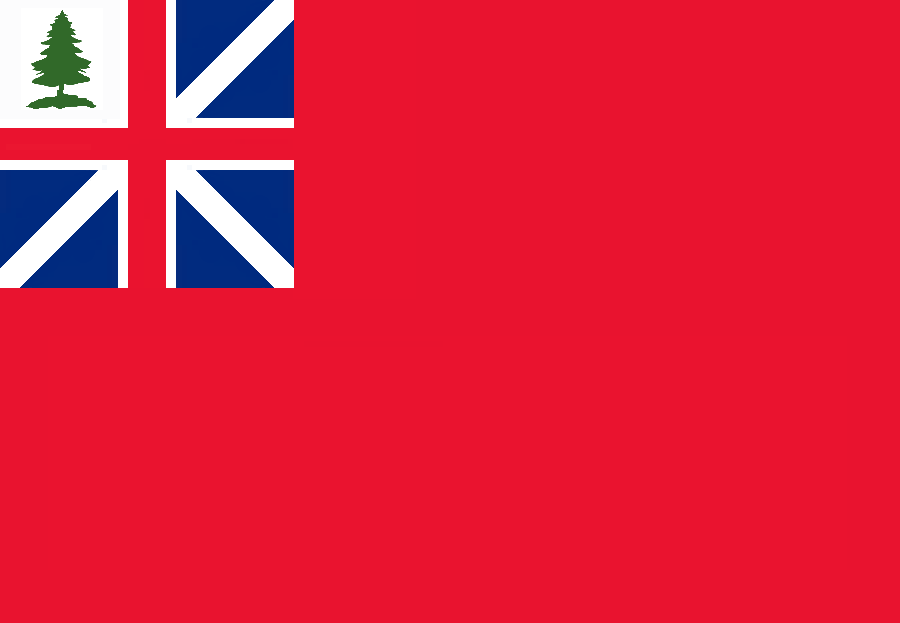


 There are a number of versions of a flag that was known as the Pine Tree Flag. The most common version is the one shown at the top of this page: a green pine tree on a white background forming a canton placed on a solid red field.
There are a number of versions of a flag that was known as the Pine Tree Flag. The most common version is the one shown at the top of this page: a green pine tree on a white background forming a canton placed on a solid red field.
 In 1784, John Trumbull completed a painting that he titled: The Death of General Warren at the Battle of Bunker's Hill, June 17, 1775. In that painting, which is held in the collection of the Yale University Art Gallery, he depicted three flags: one British and two American. The primary American flag consists of a solid red field with a green pine tree on a white square in the canton. Trumbull was an eyewitness to the Battle of Bunker Hill, and so it would be assumed that his impression as painted in this masterpiece is accurate. This version of the Pine Tree flag, though, is the only one in which the canton, consisting simply of the green pine tree on a white background, is combined with a solid field.
In 1784, John Trumbull completed a painting that he titled: The Death of General Warren at the Battle of Bunker's Hill, June 17, 1775. In that painting, which is held in the collection of the Yale University Art Gallery, he depicted three flags: one British and two American. The primary American flag consists of a solid red field with a green pine tree on a white square in the canton. Trumbull was an eyewitness to the Battle of Bunker Hill, and so it would be assumed that his impression as painted in this masterpiece is accurate. This version of the Pine Tree flag, though, is the only one in which the canton, consisting simply of the green pine tree on a white background, is combined with a solid field.
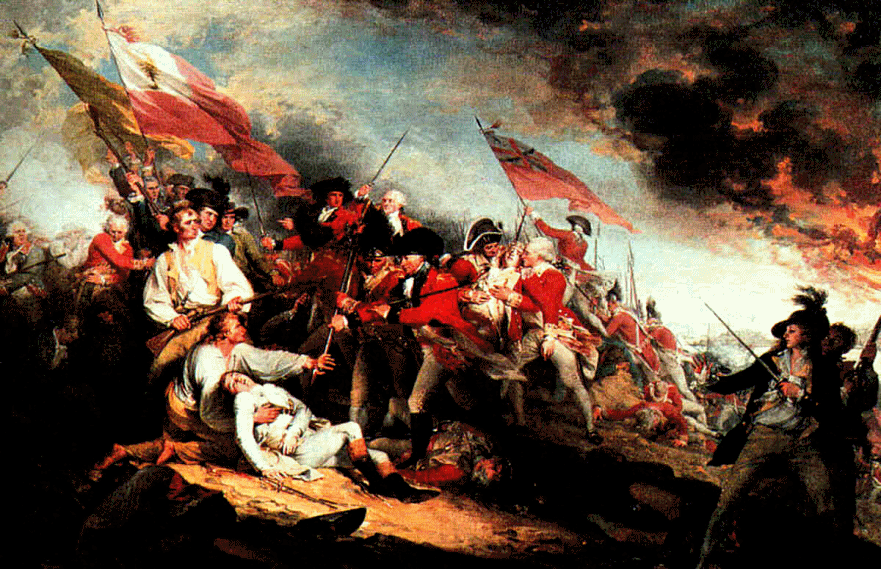
The Death Of General Warren At The Battle Of Bunker's Hill, June 17, 1775
John Trumbull, painting
This image maintained by the Yale University Art Gallery, New Haven, Connecticut.
 Trumbull's The Death of General Warren at the Battle of Bunker's Hill, June 17, 1775, which is held in the Museum of Fine Arts in Boston, is slightly different from the version held by the Yale University Art Gallery.The primary American flag in this version consists of a solid blue field with a green pine tree on a white square in the canton. As shown below in this second version by Trumbull, the field is blue rather than red. The Revolutionary War And Beyond website suggests that the variation in the color of the flag is due to discoloration of the painting through age ~ but that does not explain why the British soldiers' red uniforms haven't turned blue over the years. The fact of the matter is that Trumbull, as many other artists of his age, produced more than just one copy of his paintings, and because each copy had to be painted by hand, some variations between each copy might occur. Perhaps he painted the American flag in this version as having a solid blue field simply for the sake of providing a counterpoint to the small portion of blue ocean seen in the right side of the picture. He might also have chosen to paint the field in the British flag as gold rather than red for a similar artistic reason.
Trumbull's The Death of General Warren at the Battle of Bunker's Hill, June 17, 1775, which is held in the Museum of Fine Arts in Boston, is slightly different from the version held by the Yale University Art Gallery.The primary American flag in this version consists of a solid blue field with a green pine tree on a white square in the canton. As shown below in this second version by Trumbull, the field is blue rather than red. The Revolutionary War And Beyond website suggests that the variation in the color of the flag is due to discoloration of the painting through age ~ but that does not explain why the British soldiers' red uniforms haven't turned blue over the years. The fact of the matter is that Trumbull, as many other artists of his age, produced more than just one copy of his paintings, and because each copy had to be painted by hand, some variations between each copy might occur. Perhaps he painted the American flag in this version as having a solid blue field simply for the sake of providing a counterpoint to the small portion of blue ocean seen in the right side of the picture. He might also have chosen to paint the field in the British flag as gold rather than red for a similar artistic reason.
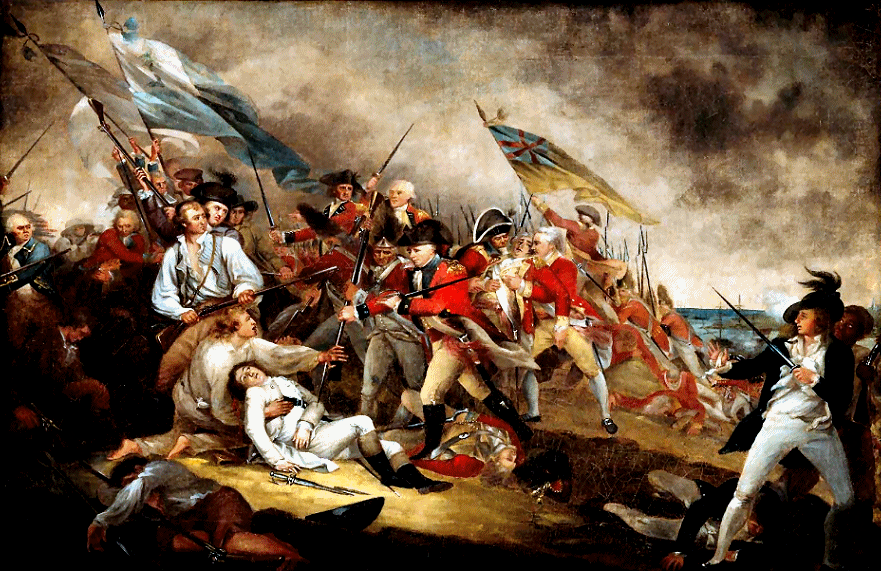
The Death Of General Warren At The Battle Of Bunker's Hill, June 17, 1775
John Trumbull, painting
This image maintained by the Museum of Fine Arts, Boston, Massachusetts.
 The New England Pine Tree flag has sometimes been pictured as a solid white field, with the green pine tree in the center, and the phrase: Appeal To Heaven across the top. Various artists have interpreted the flag with the addition of the word: An to the motto. The Massachusetts General Court resolved, on 26 July 1776, that the flag of the state navy should be: "a white Flag, with a green Pine Tree, and an inscription, 'Appeal To Heaven'."
The New England Pine Tree flag has sometimes been pictured as a solid white field, with the green pine tree in the center, and the phrase: Appeal To Heaven across the top. Various artists have interpreted the flag with the addition of the word: An to the motto. The Massachusetts General Court resolved, on 26 July 1776, that the flag of the state navy should be: "a white Flag, with a green Pine Tree, and an inscription, 'Appeal To Heaven'."
 This version of the New England Pine Tree flag was noted in the January 1776 issue of the London Chronicle as having been found on a colonial privateer that had been captured. The description was simply: "a white field with a green pine tree in the middle, and upon the opposite side, the motto - 'Appeal to Heaven'." But note that the description stated that the motto was on the opposite side from the image of the tree (i.e. image on the obverse and motto on the reverse, or vice versa).
This version of the New England Pine Tree flag was noted in the January 1776 issue of the London Chronicle as having been found on a colonial privateer that had been captured. The description was simply: "a white field with a green pine tree in the middle, and upon the opposite side, the motto - 'Appeal to Heaven'." But note that the description stated that the motto was on the opposite side from the image of the tree (i.e. image on the obverse and motto on the reverse, or vice versa).
 Also it should be noted that this version of the New England Pine Tree flag was seen in September 1775 being flown from two floating batteries on the Charles River in Massachusetts. The same flag was flown from floating batteries in the Delaware River in the Autumn of 1775.
Also it should be noted that this version of the New England Pine Tree flag was seen in September 1775 being flown from two floating batteries on the Charles River in Massachusetts. The same flag was flown from floating batteries in the Delaware River in the Autumn of 1775.
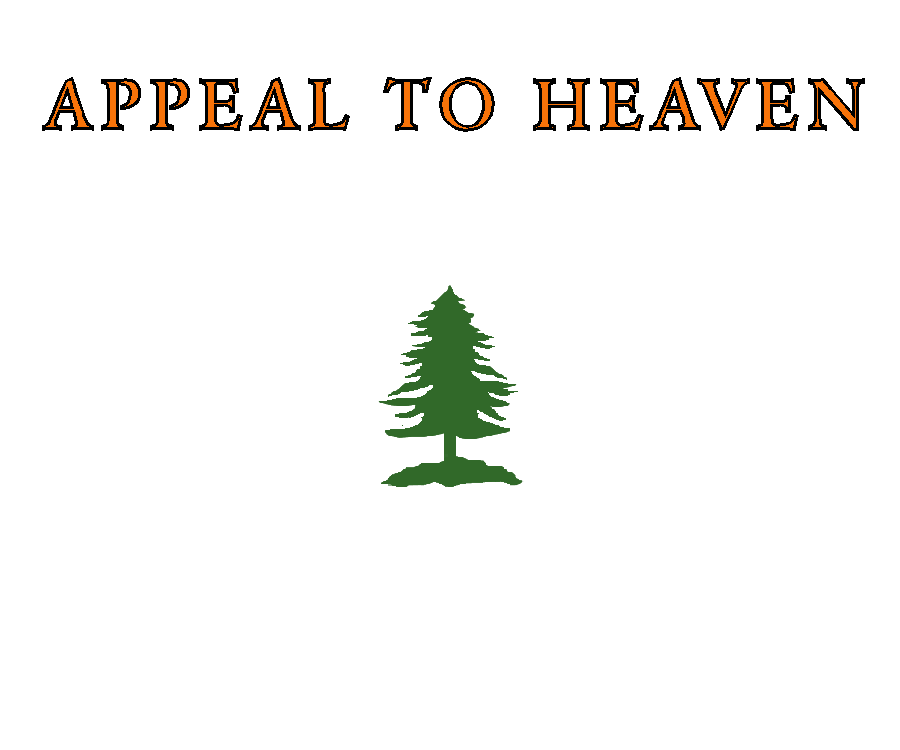
 Another variation of the New England Pine Tree flag consisted of the green pine tree on a white background for the canton of a field of alternating red, white and blue stripes ending with a red stripe at the bottom. This flag has been noted as the "John Paul Jones Coat Of Arms 1776-1777" flag.
Another variation of the New England Pine Tree flag consisted of the green pine tree on a white background for the canton of a field of alternating red, white and blue stripes ending with a red stripe at the bottom. This flag has been noted as the "John Paul Jones Coat Of Arms 1776-1777" flag.
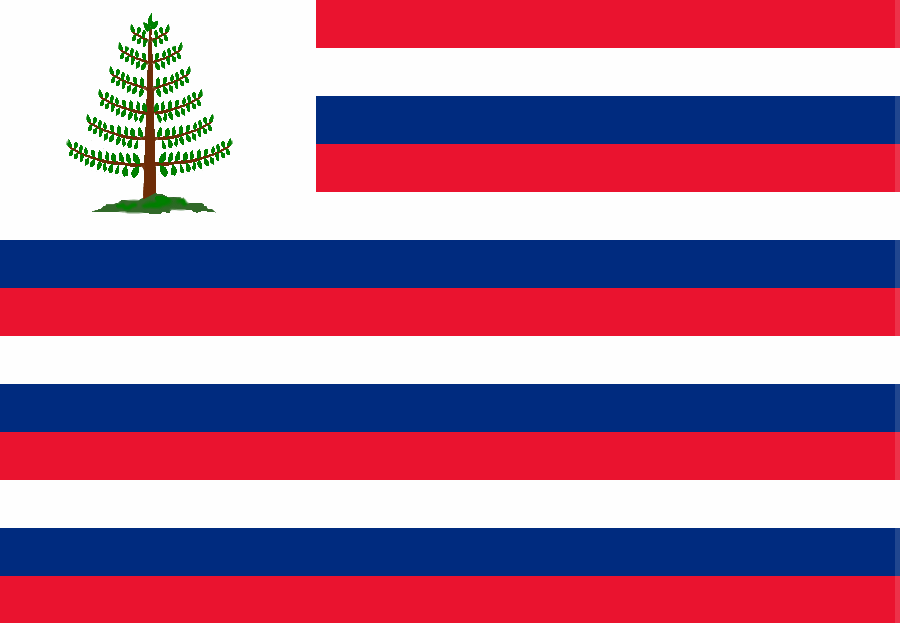
 In Volume I of B.J. Lossing's Pictorial Field Book Of The Revolution there appears an illustration of what is titled: The New England Flag. It is a variation of the New England Pine Tree flag in which the field is a deep blue and the canton consists of a white background quartered with the red St. George's Cross. In the first (i.e.the top, left) quarter is the green pine tree.
In Volume I of B.J. Lossing's Pictorial Field Book Of The Revolution there appears an illustration of what is titled: The New England Flag. It is a variation of the New England Pine Tree flag in which the field is a deep blue and the canton consists of a white background quartered with the red St. George's Cross. In the first (i.e.the top, left) quarter is the green pine tree.
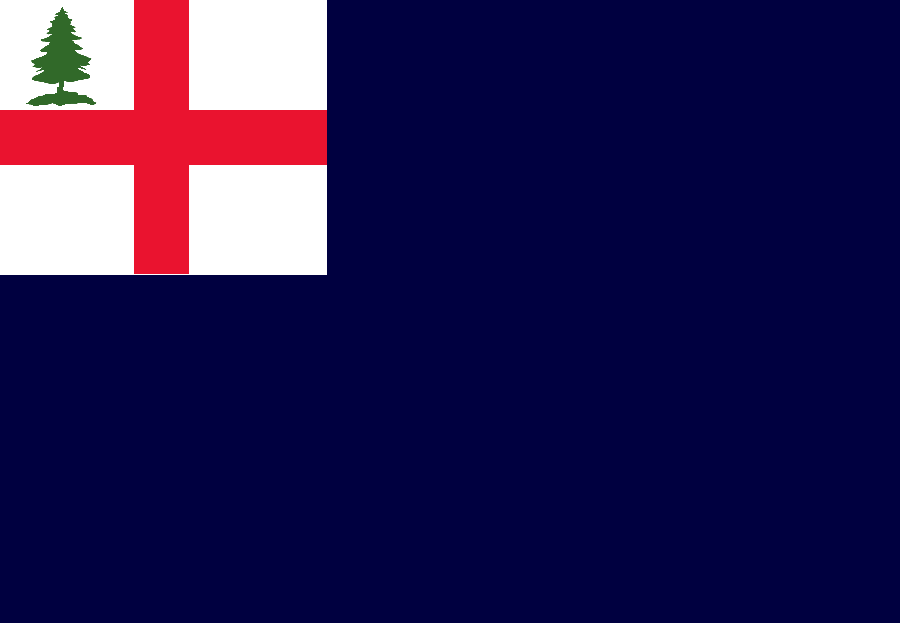
 It has been suggested by some researchers that the blue field of the flag shown above was a printer's mistake in reproducing the flag in a publication. They suggest that the flag should have a solid red field as descended from the British Red Ensign, and shown below.
It has been suggested by some researchers that the blue field of the flag shown above was a printer's mistake in reproducing the flag in a publication. They suggest that the flag should have a solid red field as descended from the British Red Ensign, and shown below.
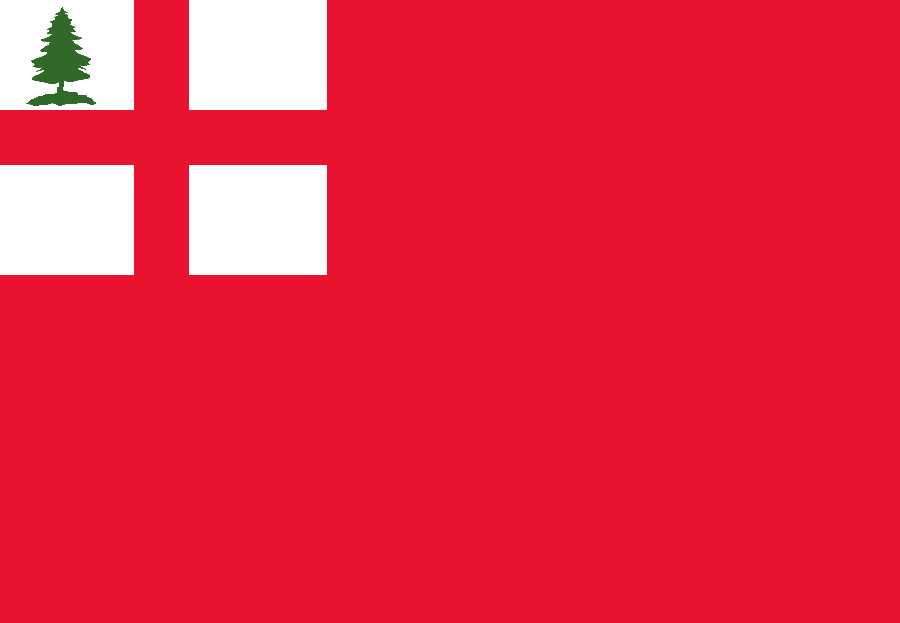
 And finally, the flag shown below is a version of the New England Pine Tree flag which started as a British Red Ensign and then was altered by the insertion of the pine tree image into the first quarter (i.e. top left) of the canton.
And finally, the flag shown below is a version of the New England Pine Tree flag which started as a British Red Ensign and then was altered by the insertion of the pine tree image into the first quarter (i.e. top left) of the canton.
